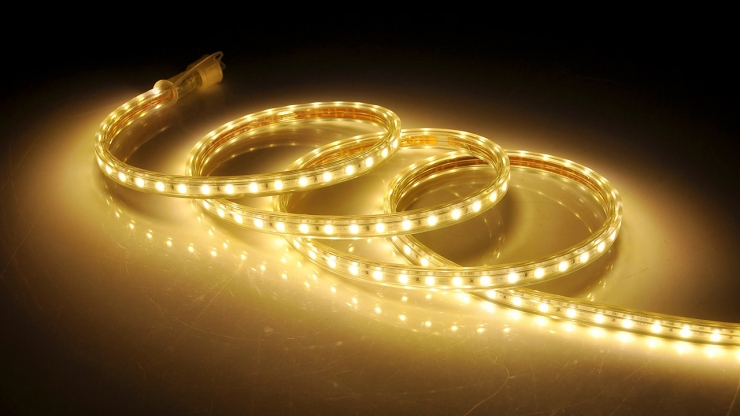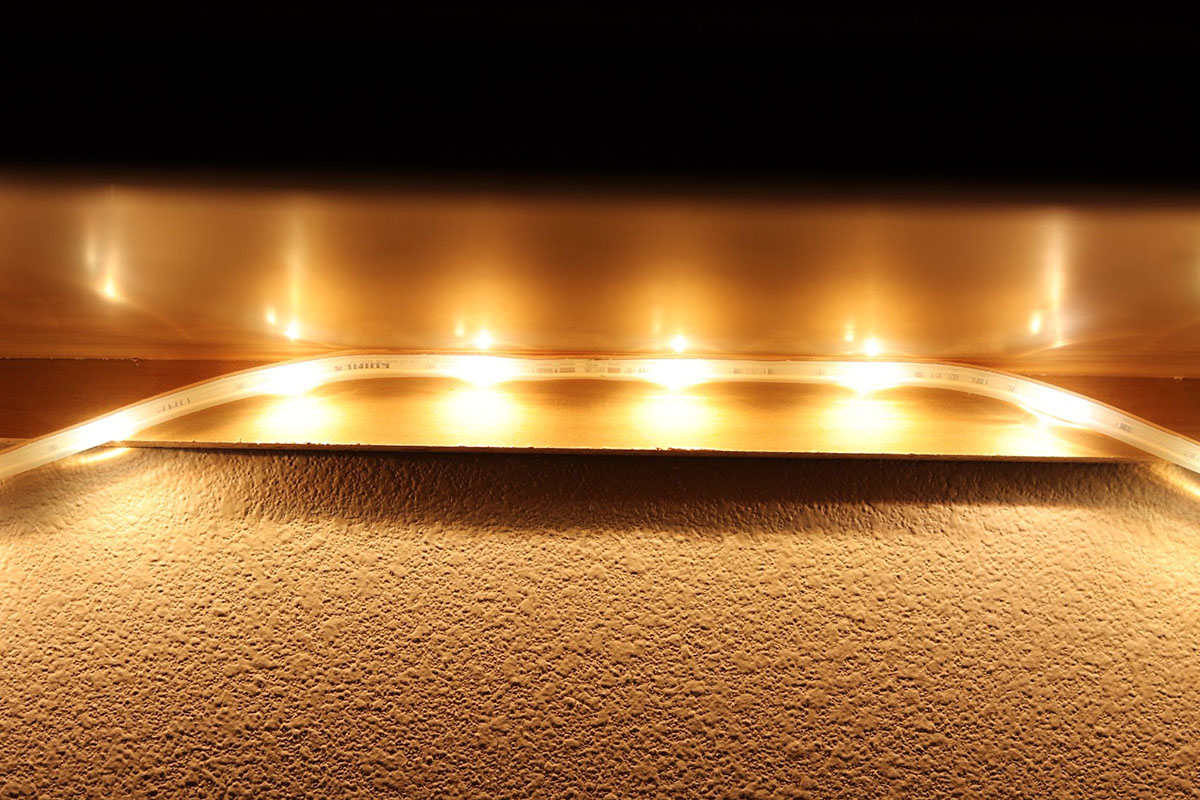How do LED strip lights work?
LED strip lights are a type of light that uses light-emitting diodes (LEDs) to produce light. LEDs are small, energy-efficient lights that can be used for a variety of purposes, including lighting up homes, businesses, and other spaces. LED strip lights are typically made up of a series of small LED lights that are mounted on a flexible strip. This allows them to be easily bent and shaped to fit around corners and other obstacles.
Advantages of LED strip lights
LED strip lights are becoming increasingly popular due to their many benefits. They are affordable, eco-friendly, and versatile – making them a great choice for both residential and commercial spaces. If you are considering installing LED strip lights in your home or business, here are some of the advantages to consider:
Eco-friendly
LED strip lights are a great choice for eco-conscious consumers. They use significantly less energy than traditional light bulbs, making them a more environmentally-friendly option. In fact, LED strip lights can use up to 90% less energy than incandescent bulbs and up to 50% less energy than fluorescent bulbs.
Decorate With Energy-Efficient LED Strip Lights
Affordable
LED strip lights are also very affordable. They are priced similarly to traditional light bulbs but last significantly longer. This means that you will save money in the long run by using power-efficient LED strip lights instead of traditional light bulbs.
Versatile
LED strip lights are also very versatile. They can be used in a variety of settings and applications and can be easily customized to fit your needs. Whether you are looking to light up a small space or want to create an elaborate display, LED strip lights are a great option.

How much electricity do LED strips use vs other bulb types?
Types of bulbs include:
- Incandescent light bulb = 15-60 watts
- CFL (compact fluorescent) light bulb = 7-13 watts
- LED strip lights use only 1 watt of electricity. You can save up to 90% by using LED strip lights instead of incandescent bulbs!
Incandescent bulbs use the most electricity, followed by fluorescent and LED strip lights. Halogen bulbs use less electricity than incandescent bulbs, but more than fluorescent and LED strip lights. Compact fluorescent bulbs use the least amount of electricity of all the bulb types.
LED strip lights are a type of light that uses light-emitting diodes (LEDs) to produce light. LEDs are small, energy-efficient lights that can be used for a variety of purposes, including lighting up homes, businesses, and other spaces. LED strip lights are typically made up of a series of small LED lights that are mounted on a flexible strip. This allows them to be easily bent and to fit around corners and other obstacles.
CFL bulbs use a little more energy than LED strip lights, but last about 10 times as long. Halogen bulbs use a lot of electricity and don't last as long as CFL or LED strip lights.
Do LED strip lights use a lot of electricity?
One common question about LED strip lights is whether or not they use a lot of electricity. The answer to this question depends on the specific LED strip light in question. Some LED strip lights use more electricity than traditional light bulbs, while others use less electricity.
In general, LED strip lights use a lot less energy than older types of lighting such as incandescent and fluorescent lighting.
LED lights are far more energy-efficient than traditional bulbs. Regular light bulbs convert only 10-20% of the total amount of energy they consume into light, while LEDs convert upwards of 90%. Although an LED strip can use up to five times more energy than a regular bulb when turned on, it uses much less when left idle.
On the other hand, fluorescent bulbs are about four times more efficient in terms of producing visible light. All things considered though, common household lighting consumes only a negligible amount of power compared to electrical appliances like TVs and refrigerators.
If you are looking for an eco-friendly alternative to traditional lighting options or if you want to save money on your electric bills, power-efficient LED strip lights may be the best option for you.
What about connected strip lights?
The amount of electricity that connected LED strip lights use depends on how they are controlled. If you have a smart home with a central hub, the amount of electricity used by your strip lighting will depend on the product's energy efficiency and responsiveness to commands from the hub.
Some types of light controls cost slightly more than others, but can often save you money in the long run because LED strips do not use as much power when idle. Another thing to consider is whether or not your control device needs a direct connection with your lights for them to work properly.
Many plug-in controllers only require an outlet within two meters or so from where you plan to install your LED strip lights, which allows you to place them wherever you need them without worrying about excessive wiring.
Nearly all connected LED strip lighting options are more energy-efficient than standard incandescent, fluorescent, halogen, and CFL lighting. Controlling your lights remotely through a smart home hub can also help you save money on your electric bill.
How much do LED strip lights cost?
Another common question about LED strip lights is how much they cost – both initially and over time. The initial price that you pay will depend largely on which type of product you purchase, where that product is manufactured, and other factors like warranty periods. When buying from reputable companies in the United States, expect to pay anywhere from $1-$10 per foot for a high-quality LED strip light.
The cost of running LED strip lights is also lower than the cost of running other types of lights. LED strip lights use only a fraction of the energy that incandescent and fluorescent bulbs use, which means that you will save money on your electric bills by switching to LEDs. In general, you can expect to save around $50-$100 per year on your electric bill by using cost-effective LED strip lights instead of traditional lighting options.
Can I calculate the LED strip light's power consumption?
Calculating LED strip lights' power consumption is not straightforward. It will depend on your specific light fixture, as well as the size and type of the LEDs used to construct the fixture.
Trying to calculate how much a single meter of LED strip lighting costs you per hour would be highly impractical – it could take hours just to crunch the numbers! Since all LED strip lights have internal circuitry that regulates power input and output levels, detailed specifications are usually only available from the manufacturer.
The best way to estimate how much an individual light fixture consumes is by multiplying its wattage by a certain number. For example, if you have an LED strip light with 12-watt diodes built into it, multiply 12 watts by four diodes (since four diodes are wired in parallel) to get a total wattage of 48 watts. Since the typical voltage for LED strip lights is between 12 and 24 volts, you can assume that your 48-watt fixture consumes approximately two amps of current when on.

How to install LED strip lights?
The most popular way to install LED strip lights is by converting existing fluorescent light fixtures. Because fluorescent bulbs and ballasts use a lot of energy and generate excess heat, replacing them with efficient LED strip lights can help you reduce your electric bill significantly while also making your workspace more comfortable to work in.
A common misconception about installing LED strip lighting is that the process requires a lot of technical expertise or specialized tools. In reality, you can add LED strip lighting to nearly any surface with little trouble using some adhesive tape and a few basic tools. Since most types of LED strips are waterproof, they can be used inside or outside without causing damage from moisture exposure.
If you need some flexible lighting options for an area that experiences a high level of foot traffic, LED strip lights are a great choice for you. Unlike fluorescent lights, which burn out quickly when they get jostled around or kicked, LED strip lighting is durable and designed to withstand the rigors of daily use.
Can I use my existing controller?
If you already have an automated light system or remote control device installed in your home, it might be possible for you to use that device with your new LED strip lighting system. However, this will depend largely on which type of control technology your LED strip lights use (see above). You may also need additional equipment like timers, dimmers, etc. to properly operate your new LED lights via an existing control system. If you need help configuring your LED strip lights to work with your existing controller, consult the manufacturer or an expert in home automation for assistance.
LED strip lighting is a great way to add some flair and personality to your home, and it’s also a more efficient and cost-effective option than traditional lighting options. In this article, we’ve answered some of the most common questions about LED strip lights – including how much they cost, how much power they use, and whether or not you can use an existing light controller. If you have any other questions, be sure to consult the manufacturer or an expert in home automation for more information.
Are there benefits of replacing standard lights with LED strip lights?
There are many benefits of converting to LED strip lights. Some of the most notable advantages include:
- Reduced energy consumption – LED strip lights use significantly less energy than traditional light bulbs, which can result in significant savings on your electric bill.
- Increased lifespan – LED strip lights typically have a lifespan of 50,000 hours or more, compared to only 1,000 hours for traditional incandescent bulbs.
- Low heat output – LED strip lights produce very little heat, which can be especially beneficial in areas where you want to reduce the amount of ambient heat (like in a home office).
- Vibrant colors and a wide range of brightness levels – Unlike fluorescent light fixtures, which often require special color filters to achieve certain hues, LED strip lights can produce any color imaginable without the need for filters. They also offer a much wider range of brightness levels than fluorescent lights, so you can customize your light output to match your needs.
- Waterproof – LED strip lights are designed to be waterproof and can be used in wet or humid environments without causing damage.
If you’re looking for an efficient and cost-effective way to light up your home, LED strip lights are a great option to consider.






